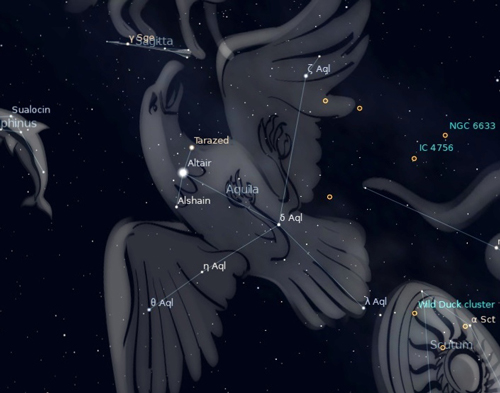This Week’s Sky at a Glance, July 29 – August 5 ~by Curt Nason
After twilight the bright star Altair is halfway up in the southeastern sky, forming the lower peak of the Summer Triangle with Vega and Deneb. It is flanked by two somewhat dimmer stars, Tarazed and Alshain, and the trio forms the head of Aquila the Eagle. The eagle’s body and tail stretch southward, while the wings reach forward to propel it up the Milky Way. In Greek mythology the eagle was the pet of Zeus and the bearer of his deadly thunderbolts. In Chinese mythology Tchi-Niu (Lyra) was a princess and royal weaver, and Kien-Niou (Aquila) tended the king’s cows. The two fell in love and were married but they subsequently neglected their chores. Angered, the king placed the herder on the opposite side of the river, represented by the Milky Way. On the seventh day of the seventh month all of the magpies in the country form a bridge to allow the lovers to be together for one day.
Following a string of stars beyond the eagle’s tail, over the constellation border into Scutum the Shield, a binocular search will pick up a smudge of light which is a cluster of stars called M11 or the Wild Duck Cluster. From the eagle’s head toward Cygnus or Lyra is a tiny constellation called Sagitta the Arrow. Look to the upper right of the arrow’s fletching with binoculars to see a popular asterism of about a dozen stars. Although it is upside down you will recognize the Coathanger Cluster.
This Week in the Solar System
Saturday’s sunrise in Moncton is at 5:58 am and sunset will occur at 8:52 pm, giving 14 hours, 54 minutes of daylight (6:05 am and 8:55 pm in Saint John). Next Saturday the Sun will rise at 6:06 am and set at 8:43 pm, giving 14 hours, 37 minutes of daylight (6:13 am and 8:45 pm in Saint John).
The Moon is at first quarter on Sunday, allowing for great views at star parties this weekend, and it passes near Saturn on Tuesday. Jupiter is sinking lower in the west as dusk, setting before 11:30 pm this week. Mercury is at greatest elongation this weekend, about halfway between the Sun and Jupiter and setting an hour after sunset. Venus is the bright Morning Star, rising around 3 am and situated approximately where the Sun resides at the summer solstice.
Astronomy clubs across the country are participating in a public National Star Party on the evening of July 29. New Brunswick locations are at Mactaquac Provincial Park, the Irving Nature Park in Saint John, and the Moncton High School Observatory. The Saint John Astronomy Club meets in the Rockwood Park Interpretation Centre on August 5 at 7 pm. All are welcome.
Questions? Contact Curt Nason.

